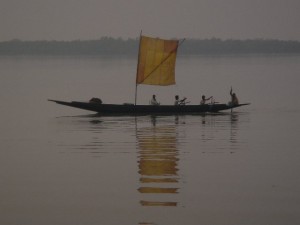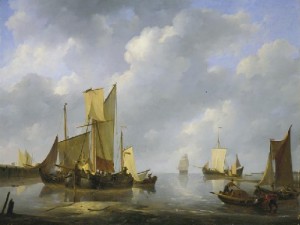
Sailing vessels are perhaps the most beautiful, most environmentally benign machines the world has ever known.
But what really sets a sailship apart from other machines is that its functioning is critically dependant on language: underlying the intricate web of its rigging, is an unseen net of words without which the articulation of the whole would not be possible.

To work a sailship efficiently, dozens of men must respond simultaneously to a single command; the failure to do so could make the difference between tacking a vessel neatly or tipping her over on her beam ends.
But to learn a series of commands is not enough:

on a sailship, as in a language, verbs need nouns to create meaning. And in one of its aspects, a sailship is precisely a vast, floating lexicon, with thousands of named parts – not just every rope, but every gasket, leech and pin has its own name.
This is why the technology of sail generated a shipload lexicographers:

from the 16th century onwards, most maritime nations in Europe needed dictionaries of sail, many of which were enormous compilations, hundreds of pages in length.
It is one such that provides us with a refracted glimpse of the rigging of words that underlay the ropes of lascar-manned vessels.[i] This is Lieutenant Thomas Roebuck’s An English And Hindostanee Naval Dictionary, first published in Calcutta in 1811.
Born in 1781, Roebuck was a skilled linguist, who had served a rigorous apprenticeship under the famous John Borthwick Gilchrist, author of the first major Hindi-English dictionary. From 1806 to 1809 Roebuck was in Edinburgh assisting Gilchrist to prepare his lexicon. After that, while traveling to Calcutta on the Hon’ble Company Ship Larkins, Roebuck passed his time by compiling his Naval Dictionary with the help of the help of the ship’s serang, a man called Ulee from Kachh (Cutch). Roebuck found Serang Ulee to be a ‘most intelligent man’, extremely ‘willing and active’, but on arriving in Calcutta, he took the precaution of cross-checking his entries with three other serangs, Shekh Duolut of ‘Chutganw’ (Chittagong in today’s Bangladesh), Shekh Mohummud, from ‘Koolabu’ (possibly Colaba, which was then an island adjacent to Bombay), and Yoosoof Surhung, from ‘G,hog,ha’ (probably the coastal town of Ghogha, in Bhavnagar district in Gujarat).

Roebuck did not long survive the publication of his dictionary, dying of a fever in Calcutta at the age of 38.
But he did live to see the proof of his work’s usefulness, for in 1813, two years after its first publication, his Dictionary was reprinted by the East India Company’s booksellers in London. In 1882 it was revised and reissued by a missionary called George Small, under the title A Laskari Dictionary Or Anglo-Indian Vocabulary Of Nautical Terms And Phrases In English And Hindustani.[ii] Under that name it continued to circulate well into the 20th century.
[i] Roebuck, Thomas Lt.: An English And Hindostanee Naval Dictionary Of Technical Terms And Sea Phrases As Also The Various Words Of Command Given In Working A Ship, &C. With Many Sentences Of Great Use At Sea; To Which Is Prefixed A Short Grammar Of The Hindostanee Language. Calcutta printed. London: Reprinted for Black, Parry & Co. Booksellers to the Hon. East India company, Leadenhall Street, 1813.
[ii] Roebuck, Capt. Thomas: A Laskari Dictionary Or Anglo-Indian Vocabulary Of Nautical Terms And Phrases In English And Hindustani, revised and corrected by George Small, W.H.Allen & Co., London, 1882.
